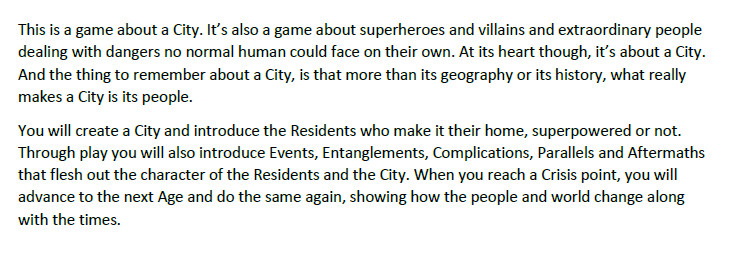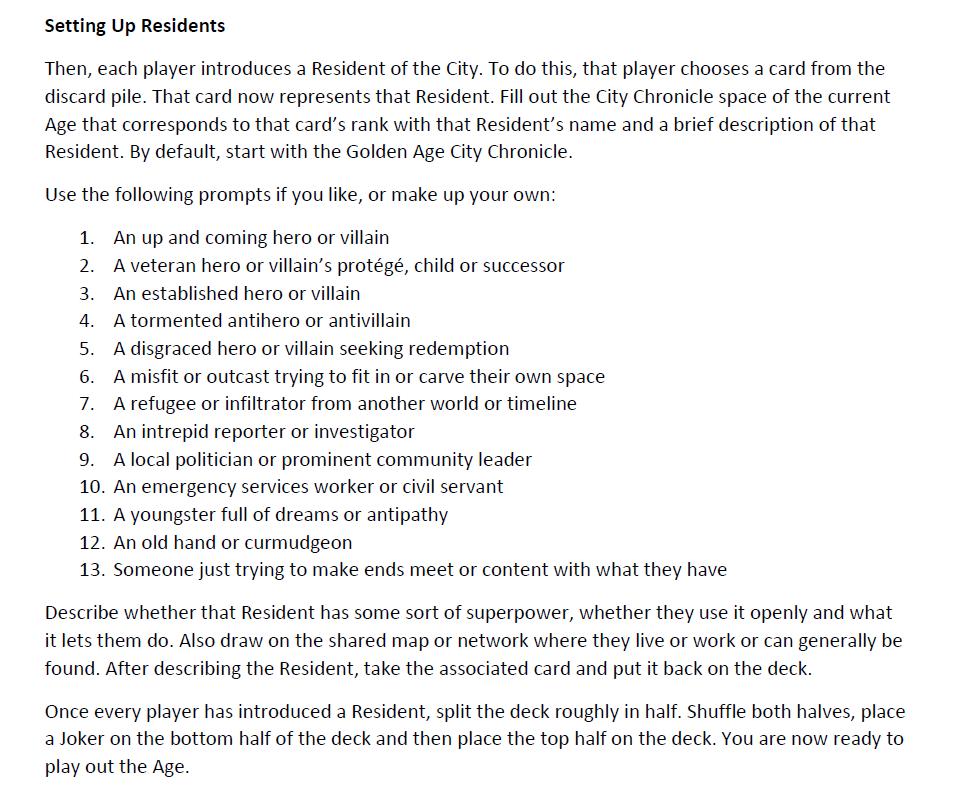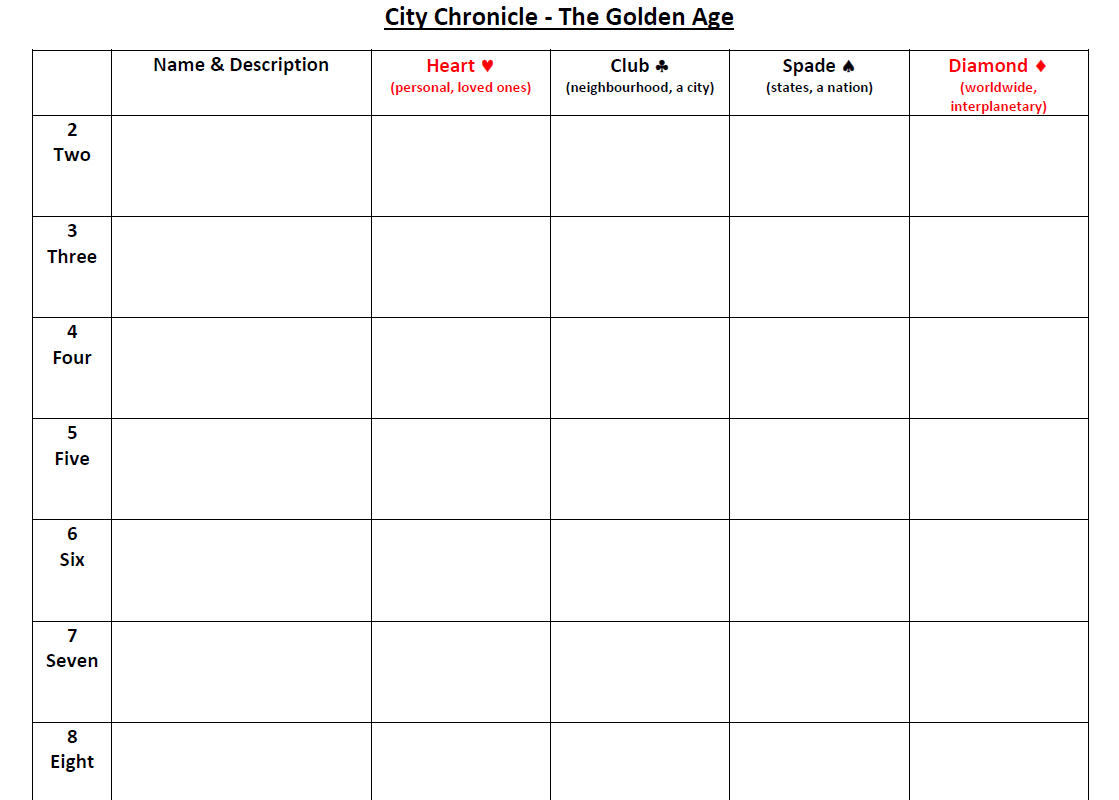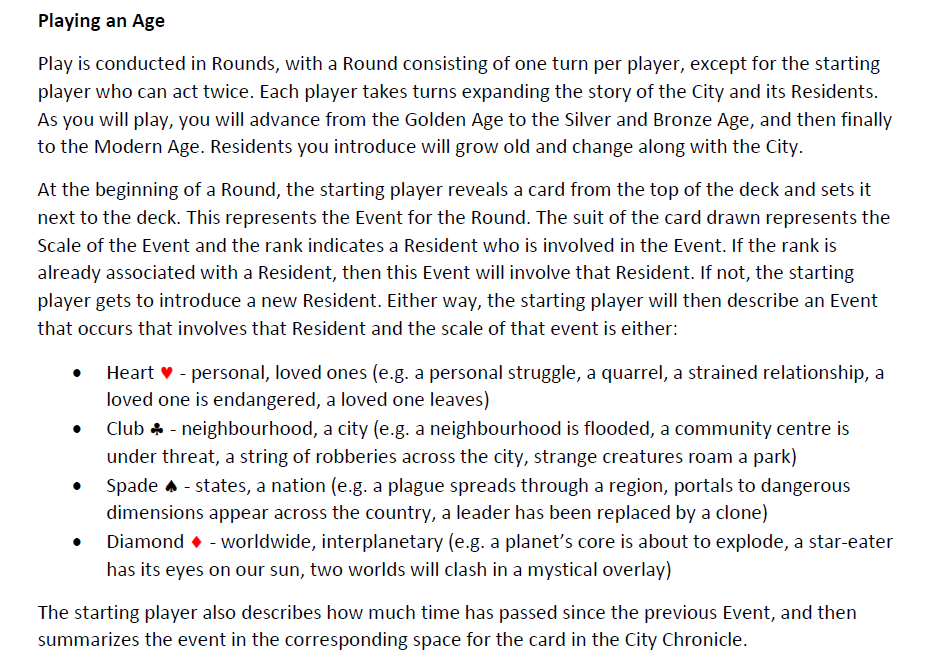A City of Shining Stars Designer Commentary 01
A City of Shining Stars was one of my submissions for #beyondsuperjam back in March. Thematically, it draws heavily from Kurt Busiek's Astro City, and its concept of a living, growing, aging city and its superheroes. I knew I wanted a city to be pivotal to the game, and the focus would be situating the superhero characters in that city and seeing how they influence each other. I also really wanted to highlight the theme of a continuity and legacy for the characters, so I also looked to Astro City's Dark Age story arc about the changing of the times within the setting.
With those goals in mind, I looked to story games about places and times like Microscope, i’m sorry did you say street magic and The Quiet Year for inspiration. In hindsight, Downfall and its Haven creation was also another design touchstone.
I tend to write the blurb explaining the high concept of the game pretty early on, and then adjust it as I need to later. The blurb/intro for this game didn't change that much from when I started it, as I had a pretty clear idea of what I wanted to do, though I updated it to include the final game terms.

I've also started to incorporate game Principles more, which is one of my favourite bits of design from Apocalypse World and its legacy. The Principles are as much the rules of the game as the other "mechanical bits", and also serve as a great lodestar for me as the designer.

The first principle (Collaborate, but do not conduct) is something that I have found central to my enjoyment of games like Microscope, where a huge part of it is learning to trust my fellow players and be delighted by what they create. I wanted that to be front and center here.
The next three principles are related to the specific expression of the superhero genre (Astro City, Top Ten) that I am drawing upon and trying to evoke and encourage. You could take the tools in the game and tell a bombastic chronology of a heroic legacy, but it's not really all that I am after. It's the little details, the shining of the spotlight at places that aren't usually where heroic narratives are focused to find interesting stories, connections and themes that make me love Astro City. I wanted the principles to communicate some of that.
The final Principle (Play safely) is something of a Zeroth Law that should underpin all games. I've been experimenting with different ways of incorporating or highlighting safety, and in this one I tried putting it with the Principles as a way of framing it as part of the design and intent of the game.
Now that the Principles informing the game are set, let's see how to create the City. I knew I wanted a list of prompts that would relate to the playing cards that you would be using in the game. Of the available possibility spaces (4 suits, 13 ranks, 52 cards etc), 13 prompts based on card ranks seemed the most reasonable for granularity vs effort.

As an aside, I love the different options that playing cards present for possibility spaces (based on rank, suit, even/odds, totals, deltas, sets, runs, or other combinations) even for something as simple as a random table vs just getting a simple value from a die roll.
I set up the prompts by building up different sets of associated ideas, which is a method I tend to use a lot. For this list it was based on landmarks (natural, man-made, transport), history (new, old), use of space (economic, cultural, spiritual), demographics (poor, rich), and cultural touchstones (stories, sports, food). I also ask for two names for the city to highlight the importance of history of places. I realise that names are really important to me in the games I design, and in this one I wanted players to think of why and how a city gets named, and what it might mean for a place to change names.
You will also note that instead of instructing to draw a random card for a prompt, I ask the players to discard them. Besides acting as prompts for creating the city, this process also sets those same cards up for the next step as prompts for creating Residents (characters). I wanted the City to come first and set the context for the Residents and let the players reflect on how the Residents would fit within the ecosystem of the City.

After acting as a second prompt, half the cards then get added back into the deck. There's an interaction here that isn't obvious, but this allows a small degree of control over the narrative that might play out since you know there are some cards that are now out of the game. For the Resident prompts, they weren't really organized thematically, but I did try to hit 3 rough categories: obvious superhero/villain tropes, obvious mundane residents, and prompts that could work for either.
Besides the map of the City that you build together, the main repository of information is the City Chronicle. This tracks all the Residents you introduce to the game, the events they get involved in and the cards that are associated with them.

The City Chronicle not only acts as a central repository for information relating to the current Age, but also acts as reference for later Ages. You can refer to the older City Chronicle in later Ages when introducing new Residents, and link them to prior characters or events.
So how do you actually play out an Age? I patterned the player turns and rounds after a mix of The Quiet Year and Microscope. During a player's turn, they get a prompt that lets them expand on an existing Resident's story or introduce a new Resident and their story. Then other players can expand on the story introduced by the initial player, but rather than the freeform nature of Microscope, the elaborations are again driven by prompts that are based on how much of the initial prompt card they match.

In early versions of the game, this was pretty much it. You introduce new people and events and just keep expanding on them like a game of Microscope. However, as it was possible to introduce an event or character and then have no more say over that event or character after other players added their contributions (e.g. all the players could end up drawing the same rank card), I wanted to offer a way for the initial player to cap off the event they introduced. I added the Aftermath, which let that player narrate the final scene of the event.

The Aftermath also works like a kind of resolution roll to see whether an event goes well or not, like a traditional RPG. I figured this would add a bit of that flavour of dramatic tension from superhero comics to the final flip of the card, rather than just as new prompts.
Next I'll expand on how the prompts were designed for the Complications, Entanglements, Parallels and Aftermath. Complications and Entanglements were pretty easy. Ranks and Suits already mean something in the game, so making matches lets you activate the other half of the new prompt card i.e. matching Rank (character) meant the Suit would dictate a new Scale of the Event for that same Character, while matching Suits would rope in another character (identified by Rank) to the same Event.
The tricky one for me was what to do when there was no match. I was stumped on this option for a while until I remembered that superhero comics often used the trope of side plots that seemed innocuous but still reinforced or paralleled certain themes in the main plot, which led me to the Parallel outcome.
The way to resolve Aftermaths was initially more complicated (I think it involved counting matching ranks or suits or something like that) but I ended up just going for a simple colour match. This let the existing meanings associated to the card suits and ranks stay simple.
So that's how a round and turns work within an Age. I knew I wanted the progression of Ages and characters aging and changing with the Ages, so I used a Joker in the deck to trigger the changing of an Age. This also triggers a Crisis event, which is a well-worn trope in superhero comics that fit well here.

The Crisis provides a way to go back to key characters in the previous age and give them one final dramatic scene as part of the Crisis event, and then pave the way to introduce new characters to the City. The Crisis also allows major changes to the City for the next Age, again reminding players that the City is a central character of the game. The new Residents that get introduced are tied back to the old Residents through the shared Ranks, which I did to allow thematic links between the Ages more clearly. You could probably play a Legacy style variant of the game where you write on the card the names of all the Residents it has represented through the Ages, which could be pretty cool.
And that's it for the meat of the game. I recommended going through the Golden, Silver, Bronze and Modern Ages to reflect the common understanding of superhero comic period, but you can adjust the number of Ages that you play and what the Ages mean to suit your game.
I started up a solo playthrough to playtest the game, but only made it as far as the City set up. That little bit was quite fun and one of the applications I'm most excited for with this game is to use it as a shared worldbuilding session zero for a campaign, but it could work as a solo exercise too, so I'm hoping to continue it. I was also really flattered and excited to see that another game designer made a hack of this game to let you create a wrestling promotion, which is a great thematic fit.
Still, there are a couple of areas of the design that I am wary of and would pay close attention to during playtests.
First is the game length. I figure half a deck would be enough to give each player a lead round (20ish cards, 5 cards per round for a 4 player game) before the Crisis. I'm not sure if this would be too long, or whether the players would have enough Residents/Events to get the feel for an Age before transitioning to the next one. I guess you can adjust the placement of the Joker to suit your game, but I want to be able to offer some guidance in the rules.
The second is that there are a lot of fiddly set up and prompt resolution rules that might make it hard to remember how everything works. I added a player aid to try and alleviate this, but I would prefer to have more elegant design solutions.
And that's all I have to say for now on A City of Shining Stars. I hope that was at least interesting if not informative, and I hope to continue playtesting and updating this game. Let me know if you try it out and tell me what you think!
Get A City of Shining Stars
A City of Shining Stars
A story game about a city filled with extraordinary heroes and people for 2-4 players.
| Status | In development |
| Category | Physical game |
| Author | ehronlime |
| Tags | cards, GM-Less, map-drawing, Superhero, Superpowers, Tabletop, Tabletop role-playing game, worldbuilding |
More posts
- A City of Shining Stars - The Nice Layout UpdateMay 05, 2021
Leave a comment
Log in with itch.io to leave a comment.